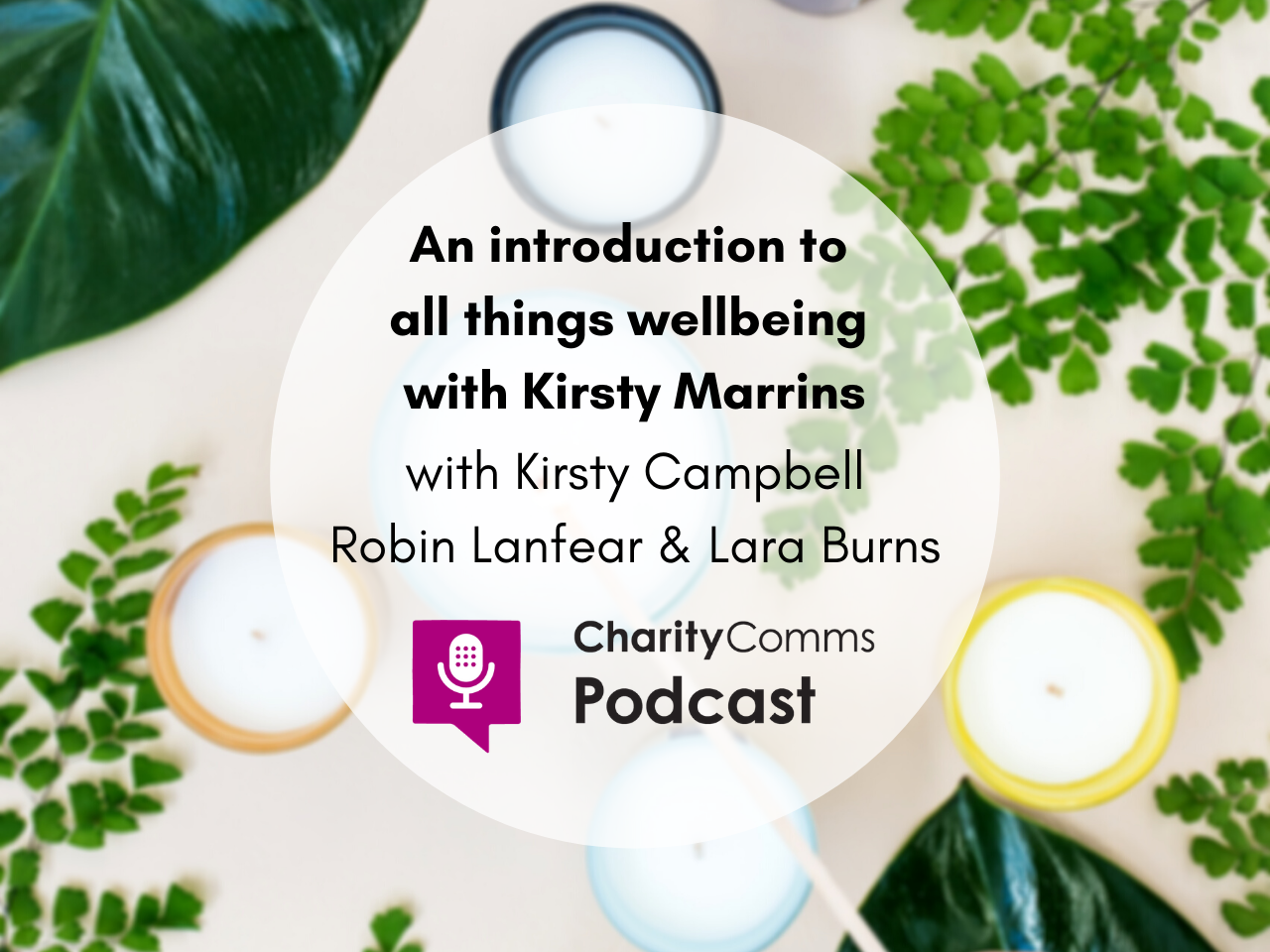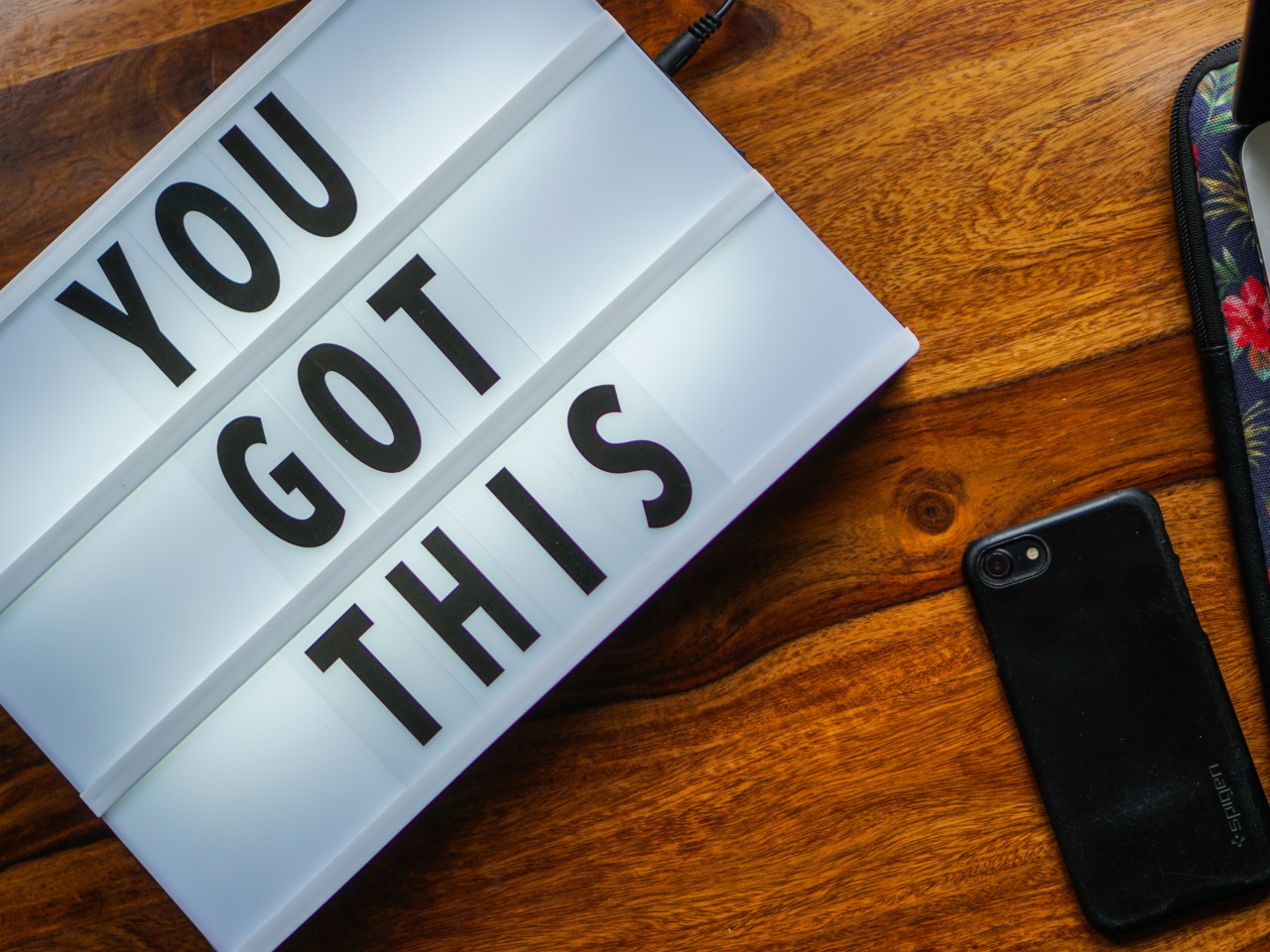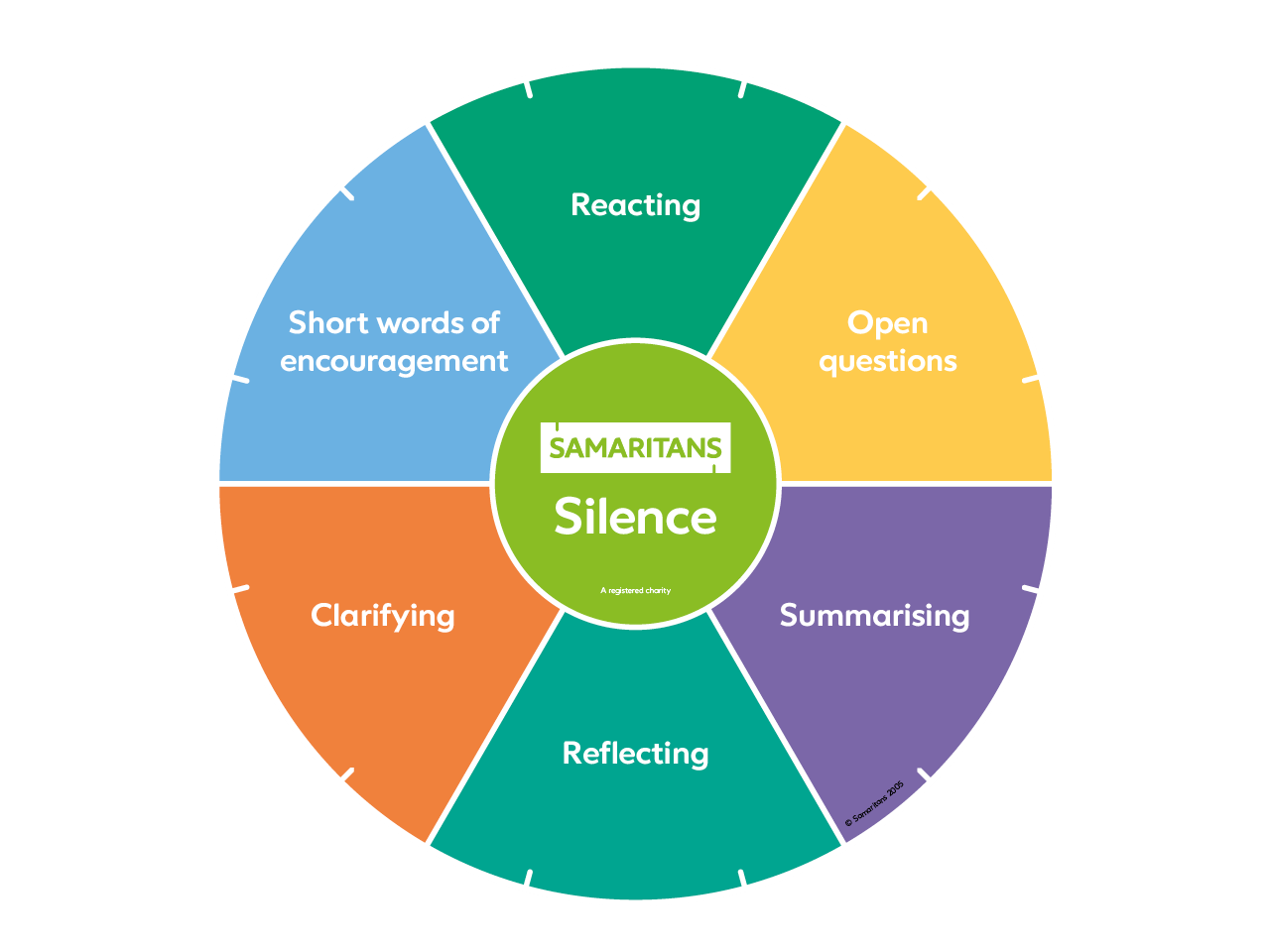A wellbeing guide for comms professionals

Taking care of our mental health should not be something that falls down the list of priorities, especially when working in the ‘always on’ culture of comms. So how do we make sure we are taking steps to protect ourselves and others?

Kirsty Marrins
Author
Kirsty is a copywriter, accredited trainer and consultant working in the charity sector. She has a regular column in Third Sector where she writes about all things digital and was named one of the 100 most influential people in the charity sector.

Lightful
Sponsor
Lightful is a technology company for social good, helping good people and great causes better realise their purpose and ambitions. Lightful’s social media management platform helps charities raise more awareness and funds for their work. Alongside this, Lightful Labs is a full-service, creative technology consultancy working with great charities across multiple cause areas transform their approach to digital.
Contents
1. Wellbeing in a social media age: An Introduction
2. Tips to improve mental health: Warning signs and advice
3. Looking after each other: Benefits of team support
4. Frameworks to protect wellbeing: Putting a plan in place
5. Building personal resilience: Strategies for self-care
6. Investing in staff wellbeing: Leadership from the top
7. How to help those around you: Checking in with colleagues
8. Wellbeing in a hybrid world: Tackling new ways of working
9. Wellbeing links and resources
Section 1
Wellbeing in a social media age
An Introduction
I’ve been working in charity communications since 2009, just as social media was becoming mainstream and gaining recognition as a channel that charities needed to be on. Over the years, the growth of social media has meant that we are closer to our supporters, volunteers, beneficiaries and even our colleagues than ever before. But with this growth comes the pressure of being ‘always on’, the expectation of needing to respond instantly and the increasing inability to switch off.
It’s not just those of us who work in social media who feel this. How often do you check your work email outside of work hours? If you work in PR, media, or any other form of direct or indirect communications, no doubt you are also ‘always on’. Technology has made it easier to check in at any time of the day or night – whether it’s emails, social media channels, WhatsApp or Slack – work is never far away. Back in 2009 I certainly didn’t have access to work emails on my phone, nor would I check social media out of office hours. So much has changed in just ten years but how much has changed when it comes to looking after our wellbeing?
In the last couple of years, there’s been a noticeable increase in charity communications crises that have both started and gained pace on social media. Most recently a children’s charity experienced one that lasted for several days. It was the relentlessness of this crisis that made me really think about the wellbeing of the teams involved and what support they were being offered. I think most organisations don’t recognise that those who manage their social media are on the frontline and are often the first point of contact for someone, whether they’re simply asking for help or support or whether they’re trolling the organisation. I wrote about it in Third Sector and the response was overwhelming, which led to the creation of this guide.

I’ve worked in a variety of organisations, from small charities to large and the range of support on offer varies hugely. With one in four of us experiencing a mental health problem, it’s imperative that we put in place tools, techniques and frameworks to help ourselves and our colleagues. In this guide, you’ll find case studies from charities on how they look after wellbeing in their organisation. There are also tips and techniques from wellbeing experts and counsellors to help you build resilience and look after your mental health.
Wellbeing is all of our responsibility. This guide is for everyone – whether you’re a sole communicator or you work in a team of twenty. Every article is written to help anyone, at any stage of their career, and with every organisation in mind. It’s also a living guide, meaning that it can be added to over time. If you’re a charity leading the way when it comes to staff wellbeing, or you’re a mental health professional, get in touch to share your tips.
A word from our sponsor…

Vinay Nair
CEO and Co-Founder of Lightful
At Lightful we passionately believe that those doing the greatest good deserve the best technology.
Having worked closely with Kirsty and our friends and colleagues at CharityComms for some time, we have been very happy to support this guide, which comes at a vital time for individuals and organisations in the sector.
Social media offers us an amazing opportunity to get to know our supporters and to have meaningful conversations with them. But we also know that there is a lot of negativity on social media, and it’s important that we know how to deal with it, and address it head-on. We started a campaign to #ReclaimSocial in 2018 as a way to counteract that negativity and to spread more positivity. So far the campaign has reached 40 million people and every month on our Reclaim Social podcast, we speak to inspiring people who are making social media more positive, one post at a time.
Collectively, we can – and must – do more to focus on that positivity and wellbeing in a rapidly evolving digital age. We are delighted to sponsor this guide; we hope it is of use to you and that it will also trigger further initiatives to support those working in charity communications to look after their wellbeing.
Section 2
Tips to improve mental health
Warning signs and advice
When we think about wellbeing at work, we tend to think about it in the context of crisis situations. Yet as a charity communication professional you are dealing with challenging situations every day. Whether it’s listening to someone who has a terminal illness tell their story or seeing abusive messages from people who don’t agree with what your organisation does, it all takes its toll.
The scale of what communications professionals deal with is vast. There are obvious causes that we would expect to bring up heightened emotions, such as charities who support people with life-limiting diseases or support those who are bereaved. And then there are charities who fight for human rights, and support refugees, who are subjected to racist abuse on an almost daily basis. Even animal welfare charities are criticised for certain policies that some people don’t agree with. Every charity is affected and so too are their staff.
It’s important to recognise the daily, ‘business as usual’ situations that you as a communications professional consistently face, that could be impacting on your mental health. Just because it’s not about you personally, doesn’t mean that it’s not internalised and won’t impact your wellbeing. Over time, the effect of hearing and seeing emotionally distressing or even abusive messages, will take its toll.
That’s why knowing the signs or common indicators of mental health issues is really important so that you can spot them and address them. Just as you might provide a duty of care to your beneficiaries or case studies, you need to be supported too.
Helen Breakwell is a qualified counsellor who previously worked in the communications team at a leading cancer charity for 15 years. Helen shares what you should be looking out for when it comes to the signs and symptoms of mental health problems – which can in some cases manifest physically – and offers seven tips to look after your wellbeing.
Charities do amazing work and those who work for them often feel like they want to do as much they can, which can lead to stress and sometimes burnout. It’s not uncommon for charity communications professionals to work beyond their required hours but this doesn’t lead to a healthy work-life balance. Nor does it help the charity if you are then signed off for stress. When you really care about the cause it can become all consuming but it’s important to make time for interests outside of work, such as a hobby or just meeting up with non-work friends.
Beyond just the internalised effects of stress and burnout, there can also be clear physical indicators as this is our body’s way of warning us that things may be amiss. Try to be more in tune with what is happening with your body so that you can spot when something isn’t quite right and you can address what’s really going on.
Consciously choosing to really switch off is highly beneficial because we need to give our minds time to rest. If you’re worried about how much screen time you’re getting, there are apps that can switch off when you put a time limit on them, or at a certain time of the day or night.
By investing some time in yourself, you’ll be better equipped to deal with stress and also to recognise it in others.
Want to learn more? Check out the podcast below as three sector experts share their tips for wellbeing at work too.
Section 3
Looking after each other
Benefits of team support
Most charities deal with challenging issues. It’s the job of a communications professional to tell the stories of those in need, and those that charities help, in a compelling and emotional way so that people will feel motivated to take action. This may be ‘business as usual’ but it doesn’t mean that it doesn’t take its toll.
The value of support in distressing situations cannot be underestimated because, over time, the exposure to emotionally challenging content will start to affect your own wellbeing if you don’t find an outlet to share and talk about your feelings.
One of the best ways to do this is to talk to a colleague or a manager about how you’re feeling, because they understand your situation as they are in it themselves. Being honest about whether something is troubling or affecting you is not a sign of weakness, it’s a sign of strength. Being able to share and unburden with your team will also bring you closer together and help improve your working relationship.
One charity who knows this all too well is Great Ormond Street Hospital Children’s Charity. The communications and digital teams work closely together to build resilience and to support each other, particularly when they’re in the media spotlight. In this case study they share six ways that they support staff wellbeing on a daily basis.
It’s so important to look after yourself and to look out for your colleagues. When you work for a cause that is highly sensitive and emotional it’s imperative to put some processes in place to ensure that the wellbeing of staff is not an afterthought.
Whilst GOSH is a large charity with access to formal support, there are lots of tips that smaller charities can take away and implement immediately. One of which is being ‘one team’. Even if you’re a communications team of one or two people, it’s so important to chat regularly with colleagues in other departments and to understand what’s going on in the organisation. With small charities in particular, upskilling others is really important too. Could you upskill volunteers to help you monitor your social media channels or plan content so that you’re sharing the workload?
Having a clear wellbeing strategy in place so that you know that the right people are being supported and there is a plan for doing this is also crucial. Impetus are a great example of an organisation who are committed to working on their wellbeing strategy regularly and adapting it to suit the needs of everyone who works there. In their own words: ” Even after you’ve launched and are delivering your strategy, you need to make sure you set aside time to evaluate and refine what you’re doing to ensure it continues to meet the needs of your colleagues.” Read their blog below for tips on how to do this:
Further to the need of having clear strategies in place no matter what workplace situation you are in, currently we are also still facing the additional challenge of many of us having to switch to remote working during the coronavirus situation. The added pressures of trying to maintain teams who are separated by location is very real and something that needs to be acknowledged.
Below is another case study, this time from Mind, offering their tips for navigating remote ways of working.
It’s up to all of us to support our colleagues, as well as ourselves. If you need support or you think a colleague needs support, have a chat. A sympathetic ear can go a long way. If you yourself need support but you feel like you can’t talk to a colleague, for whatever reason, then please call the Samaritans on 116 123.
Section 4
Frameworks to protect wellbeing
Putting a plan in place
For those of us who work in social media or in community management, sometimes it can be difficult to not take things personally. When people are upset or angry, they often forget that they are talking to a person and not an organisation. In crisis situations people can become ‘keyboard warriors’ and say hurtful and abusive things. Although it’s tough, it’s still our job to respond.
Usually in those situations you will have a prepared, signed-off statement and pre-agreed responses. But what about everyday situations?
Having a framework can be so important for a wide range of situations – from dealing with crisis communications to managing everyday conversations that may be difficult. A framework will give you a structured approach to manage how you respond to handling issues and a way to deal with your own emotional response.
Having structure can help you to look at situations objectively and to formulate the best response for the situation. Serena Snoad is an online community manager at the Alzheimer’s Society and manages the Dementia Talking Point peer support community. Serena talks us through the three stages she uses to build her framework to help deal with difficult situations.
Similarly being able to refer to tools like the Samaritans’ Listening Wheel can be useful. Especially in terms of providing structural support when dealing with challenging situations and difficult conversations.
Staff across the board at Samaritans make use of this handy tool to teach them to “actively listen” as it reminds them how techniques such as open questions, reflection and summarising can help guide then through the conversations they are having.
When faced with an upsetting message or response from someone, it can bring up a range of emotions. We may feel upset, sad or perhaps even angry. It can be tempting to just fire off an immediate response but we need to take the time to assess the situation and to give ourselves space to take a breath and put ourselves in the other person’s shoes.
As Serena points out, a framework can help you to balance your response so that it shows understanding, whilst also giving a response appropriate for your organisation.
It’s also healthy to debrief with your manager or a colleague after an upsetting incident, so that you can walk through the issue, reflect on how you dealt with it and what you could maybe do differently the next time. By sharing your experience openly, it will help you to move forward and not be consumed by what happened.
Section 5
Building personal resilience
Strategies for self-care
Due to the nature of working in communications and particularly in this fast-paced digital age, we will experience stressful times. Whether that’s working hard to meet a deadline, dealing with unexpected crisis communications or even unexpected opportunities that may arise – stress is inevitable. With social media and the ability to access everything via your phone, it’s also harder to switch off and so we feel like we’re ‘always on’.
To help us cope with stress and the pace of change, it’s important that we build resilience and prioritise self care. The first step to doing this is to identify your inner critic, acknowledge it and change those negative thoughts and doubts into more positive ones.
Try practicing mindfulness to help you feel truly present in the moment, which can help reduce stress and anxiety. Consider downloading an app, such as Headspace, to help practice mindfulness and to make it a daily habit. In this chapter, Hannah Massarella, a certified co-active coach, shares five strategies to help you build personal resilience.
Whilst it’s important to build personal resilience, it’s also important to create a culture of openness where staff feel they can speak honestly about mental health. Try to embed a culture of self-care in your team so it’s practiced every day.
As Hannah says, ‘wellbeing is inherently about people’. This is so important to recognise and acknowledge as it’s up to us to not only look after ourselves but to look out for our colleagues too. Before we can help our colleagues, we need to help ourselves so remember to address that inner critic and to replace those negative and disruptive thoughts with positive ones. Take the advice of Dr Hanson and praise yourself after something goes well. You could even keep a notebook of these moments and refer to them when you need a lift.
If your organisation doesn’t have a culture that is open about wellbeing in the workplace, perhaps it’s time to address this. Who in your organisation do you think shares your views and who could you work with to research and put together a plan that could be taken to senior management or your trustee board? There are so many examples in this guide that you can draw on and that will help provide a case for support.
In section six there is an inspiring example of a charity who is putting staff wellbeing at the heart of what they do and in section seven there are lots of tips and resources to help you support your colleagues.
For those working in social media, navigating its constantly ‘on’ nature can pose significant challenges, potentially leading to feelings of overwhelm and burnout. Therefore, it’s crucial for teams to set clear boundaries and effectively manage expectations to safeguard their wellbeing. Strategies that can help social media teams thrive include having both structure and support, encompassing well-defined processes for addressing issues, along with dedicated periods for rest and reflection.
Section 6
Investing in staff wellbeing
Leadership from the top
There are many times in our professional lives, perhaps even daily, where we may have to deal with situations that really affect us. You may not even notice it until it builds up over time, or it hits you when you least expect it – like whilst you’re cooking dinner or putting a wash on. If not addressed, these feelings can start to take an emotional toll on your wellbeing.
Two charities who have been addressing this head on are Sarcoma UK and Trinity Hospice.
First up is Sarcoma UK, who for the last eight years have made sure staff have had access to a counsellor to help them build resilience and learn how to process their feelings. They have also received training to help them learn how to draw an emotional line between work and life outside of work.
It’s an investment that’s hard to measure in numbers but it is clearly money well spent. As Bevis Man explains in this section, having access to a counsellor not only helps individuals but also makes a difference to the overall mood and atmosphere in the office. Creating a culture of talking openly and honestly about how something is affecting you, helps improve wellbeing and mental health.
Next we have Trinity Hospice who have worked hard to embed a culture of community, based on the core principles of outstanding mutual support and care. Drawing on the lessons from front line clinical and medical teams, counsellors and support staff, Trinity Hospice has managed to create the most fantastic comfort blanket for staff as well as making a concerted effort to throw a spotlight on self-care. Here’s how they have done it…
The majority of charities are funded by donors or grants, so are very careful about what they spend their money on. Many may feel that spending money on a counsellor, or wellness activities, is an extravagance or a luxury and not a necessity. I’d argue that this investment saves money in the long run.
As Hannah mentioned in section five, stress is one of the leading causes of long-term workplace absence, which ultimately costs the charity. Being able to speak to a counsellor and having an open culture around wellbeing and mental health means that staff are able to deal with, and process, their feelings better. This results in less stress and a happier workplace. It’s an investment that’s hard to measure the return on, however the benefits will be clearly felt.
A top tip to get buy-in for this kind of professional support is to put together a robust business case. Research which charities have access to professional support and ask a few of them to have a chat with you about it. Include quotes from them in your proposal to bring it to life and add a human touch. It’s important to also research all the options available and the associated costs. For example, your board may say no to a counsellor coming in to do one-on-one sessions but they may approve having access to counsellors over the phone, through a third party.
Section 7
How to help those around you
Checking in with colleagues
As we’ve mentioned in previous chapters, it’s so important to be able to spot the warning signs and symptoms of mental health issues and to build resilience so that you can better manage your mental health.
No doubt you work with others in your charity – even if you’re a sole communicator, you will work with colleagues in other departments or even with volunteers. If you’re a freelancer, you probably have a network of fellow freelancers with whom you can bounce ideas with or even partner with on projects. If you think that a team member or a peer is struggling or is very stressed, what can you do to help them?
The first thing you can do is just have a conversation with them and open the lines of communication. One of the simplest ways is to simply ask them how they’re doing. Be mindful of your environment when asking them though as if it’s in the office in front of others, they may not feel comfortable to open up. Why not go for a coffee or even a walk outside to have a talk instead?
Creating a culture of being able to speak openly about mental health in the workplace is so important. If you’re a manager, in your one-to-ones with your staff, start by asking how they are instead of asking where they are with something or what they’ve achieved.
Having permission to be honest – and having appropriate processes and support in place – means that it should never get to a stage where a lack of support contributes to having to sign someone off or even them leaving. Don’t feel you need to be an expert. Simply listening and not judging can be one of the most significant things you can do.
It can be difficult to take that first step in speaking to a colleague or peer about their mental health but it’s so important. The more open we can be, the more we normalise conversations around mental health. It will become less of a stigma or a taboo topic. But we have to start that initial conversation!
The ‘Ask Twice’ campaign is genius because it’s so simple. It’s almost a habit or an instinctive response to simply answer, “I’m fine, thanks” when someone asks you how you are. But if they asked again, your answer would probably be different.
Don’t forget though that your environment is important too when trying to start that conversation. If you think someone might want to talk, ensure you’re in a safe space away from other colleagues. Also think about what support you could put in place to help them. Perhaps it’s being flexible on the hours they work or where they work. Plus, don’t forget that simply listening and not judging can be one of the most significant things you can do.
Given the turbulent and uncertain times we currently live in, it is also important to acknowledge that we may all be facing extra pressures on our mental health as well. Difficult conversations are being had in a wide range of workplaces and understanding how to navigate these in a way that protects your own, and your colleagues, wellbeing is vital.
Looking after your wellbeing and having difficult conversations at work

Frankie Garforth
Former interim head of internal communications and engagement , RNID

Niamh Merrigan
Internal communications and engagement officer, RNID

Sinead Armitage
Information manager and chair of staff wellbeing committee, RNID

Difficult conversations are inevitable. From tricky 1:1s, addressing personality clashes and disciplinaries, to communicating challenging organisation-wide news, such as redundancies, office moves and mergers. These chats are an unavoidable but often stressful part of our working lives.
As a manager or an internal communications team, it can feel difficult to balance the needs of your organisation with the mental health and wellbeing of your people. But, whatever the message, it’s essential to keep welfare a top priority, both for the person delivering, and the person receiving the news.
Here are some practical steps you can take to help you prioritise wellbeing when having difficult conversations at work. These tips will help you get the right outcome for your people and your organisation.
1. Prepare your people
At RNID we do everything we can to equip our people with the right skills and resources to feel comfortable managing difficult conversations at work. This means pre-briefing key individuals before big announcements, arming line managers with detailed questions and answers, as well as being open to feedback if there’s something we’ve missed. We also have trained mental health first aiders and staff companions across the organisation, so everyone can talk to someone impartial if they need to.
2. Find the right person for the job
When preparing for a difficult conversation, consider who is the best person to facilitate it. If you’re preparing for a tough organisation-wide announcement, think about who the right senior leader is to deliver the message – and field questions and worries straight away. And if it’s a 1:1, could your line manager or someone from HR support you to convey the news in a better way?
3. Location, location, location
The setting is as important as the substance when having a difficult conversation. If you are communicating tough news, make sure the venue is as private as it can be. If you’re working remotely, check everyone involved has the right equipment and a decent connection to ensure your important news doesn’t get garbled by buffering.
4. Accessibility is key
When having difficult conversations, accessibility is crucial so no one is left out or misinformed. At RNID, our communications must be accessible to colleagues who are D/deaf or have a hearing loss. This means we subtitle all videos, we follow D/deaf aware meeting etiquette and our British Sign Language users receive important information in their first language. Think about your audience and how you can prioritise inclusion.
5. Give people time and space to process
It’s important to remember that the emotional impact of tough talks might reach beyond the boundaries of the conversation. Make sure you give people space to take in information and recognise people may react in different ways and at different times. You might need to personalise how you deliver the update for different individuals, and do bespoke follow ups.
6. Make use of your staff networks
Whether the news is big or small, work with your staff networks to embed an ethos of kindness and tolerance, so everyone reflects your culture when difficult conversations have to take place.
At RNID, our employee-led Staff Wellbeing Committee is helping us destigmatise conversations about mental health. They do this by promoting monthly mental health topics, encouraging staff to share their experiences, and providing practical support to people who might be going through a tough time.
7. Signpost your mental health services
Promoting your organisation’s mental health services shouldn’t just happen after difficult conversations. If someone is experiencing poor mental health in your organisation, is it easy for them to find out where to go for support?
At RNID, our staff wellbeing toolkit is on the homepage of our staff intranet, packed with resources from top tips to looking after your wellbeing, to details of our Employee Assistance Programme. So, in the tough times people can find what they need quickly and effortlessly.
Coronavirus has forced charities to make more difficult decisions than ever before. It’s essential that as the sector who is there to support others, we prioritise being compassionate to one another in these challenging times.
Section 8
Wellbeing in a hybrid world
Tackling new ways of working
The world around us has undoubtedly changed. In the past couple of years, we have seen a dramatic shift in the places and spaces where both our professional and private lives take place. But was this a shift we were ready for? And how has this impacted our wellbeing?
When it comes to our working lives, these changes have come with opportunities. Hybrid working, for example, has enabled us to have more flexibility in our day to day. But increased working from home can also blur the lines between the professional and the personal and present us with challenges around our wellbeing.
Trina Wallace, a copywriter and editor who works with a range of charity clients on a daily basis, recommends creating workplace boundaries that will support and strengthen work relationships. Think of this as a chance to communicate and define expectations. Trina says: “Your boundaries let colleagues know what they can expect from you. They’re about what you do, rather than managing how other people behave.”
Building and strengthening connections
One of the best ways to support your wellbeing and mental health in the workplace is to be honest about who you are, your needs and how you like to communicate. Everyone is unique, so finding ways to understand each other better only helps to foster and strengthen those human connections that we all need.
One way to help with relationship and team building is to create a ‘Manuals of Me’ document. This is an opportunity to lay out the ways in which you like to work and to make it easier for people to understand your motivations, preferences, and frustrations. Not only does it help people to get to know you better, it’s a great way to gain insight about those around you too.
Becky Colley, a Lead UX designer who has worked in the charity sector, loves this tool so much she has used it in three different workplaces. She believes it helps with building empathy and trust and can create stronger teams as a result. Becky says: “A Manual helps with seemingly small things too. Imagine you can tell that a colleague is having a bad day, but you know a packet of crisps will cheer them up.”
Protecting yourself and your team from burnout
It’s the phrase that unfortunately all of us in the charity sector seem all too familiar with – burnout. Different to stress, burnout is defined as a collection of symptoms that leaves people feeling physically and/or emotionally exhausted and can be a result of problems around security, boundaries or control. Events such as the war in Ukraine, fake news filling our social media newsfeeds, greater demand for our services, and the Cost of Living Crisis, to name a few, are putting additional stress and distress on charity communicators. Add to that, stretched internal resources means that we all need to be vigilant to both spot and help those who may be showing signs of burnout.
Matt Chittock, an experienced comms professional who has worked with many different charities in his career, has pulled together some great resources to help with spotting the signs of burnout and tips on how to manage it. He cites advice from Mind, the mental health charity, that includes making sure we take our annual leave, get enough sleep, and schedule in time for positive activities.
We’re all still learning
Whilst It’s been more than two years since Covid-19 changed the way we work; we are all still learning. Adapting and adjusting at pace is not the easiest thing to do so we need to be mindful to go easy on ourselves and on others.
As the hybrid workplace becomes more the norm than the exception, we need to ensure that the important conversations around wellbeing happen and that we address team morale and work/life balance.
Sarah Myers, a freelance comms professional with more than 20 years’ experience in the sector, has spoken to a range of organisations to gather advice on keeping wellbeing front of mind. From introducing ‘Wellbeing Fridays’ to protecting lunch times and offering Slack based therapy services, there are plenty of ideas to check out and try.
Section 9
Wellbeing links and resources
Wellbeing is such a vast and complicated topic that we believe the more resources you have access to the better. There are a number of organisations, in and out of the charity sector, doing wonderful work when it comes to helping us help ourselves, but navigating a path through them all can be tough.
We asked the CharityComms network for their recommendations of the best resources out there and we did some research ourselves to produce this list to help get you started.
Wellbeing resources
Mental health charity Mind has a wide range of useful resources to choose from, one that kept cropping up time and again when we asked was its taking care of yourself advice.
Samaritans have a useful wellbeing in the workplace online learning resource that’s worth checking out.
Mental Health First Aid have a section of their website dedicated specifically to managing stress in a workplace environment.
Check out the Mental Health Foundation’s handy A-Z of all things mental health.
For an easy way to find mental health services near you take a look at Hub of Hope.
A website providing lots of resources for both individuals and workplaces specifically is Time to Change.
The NHS recommend a starting point of 5 steps to mental wellbeing.
Work specific mental health resources
Mind has an area on mental health at work.
Mental Health at Work has a whole toolkit on supporting staff with mental health in the voluntary sector.
The Team have written a useful blog on how workspaces can help improve productivity and wellbeing.
Advice for self care
One piece of advice that has come up time and again is to try out the Headspace app which provides guided meditation techniques.
Another tip from members has been to take time to go for a walk and spend some time outside to give yourself a break and to help your mind switch off from work. You could check out this list of canals near you for some routes that include water and greenery, courtesy of the Canal and River Trust .
Reading tips
The Prince’s Trust’s Lizzie Dougherty recommends blogger and author Jenny Lawson’s books ‘Lets pretend this never happened’ and ‘Furiously Happy’ and Sarah Wilson’s ‘First, we make the beast beautiful’. She says:
“The books are about the authors’ experiences of living with a mental health condition and they are very uplifting as they frame mental health in a positive light.” – Lizzie Dougherty, Prince’s Trust
Maggie’s’ Graeme Manuel-Jones recommends Beth Kanter and Aliza Sherman’s book ‘The Happy, Healthy Non-Profit’.
This Huffington Post article provides insight into how mental health experts are affected by their jobs.
The wonderful Zoe Amar has written a great piece for Third Sector about ‘How to deal with online trolls’.
Michelle Kim’s Medium post on ‘How to manage your team in times of political trauma’ provides some food for thought around ensuring psychological safety in these turbulent times.
CharityComms resources
Lola Phoenix’s great advice based on first-hand experience: Tips to protect the mental wellbeing of social media managers
Zoe William’s article sharing Kidscape’s Practical tips for dealing with trolling online
Hannah Massarella’s resiliency focused tips: Calling all senior leaders: you deserve to feel well at work too
Trina Wallace’s advice for Five ways charity communicators can emotionally protect themselves
Do you have a wellbeing or mental health resource you’d like to share with us? Email us and we’ll add it to the resources page.
















